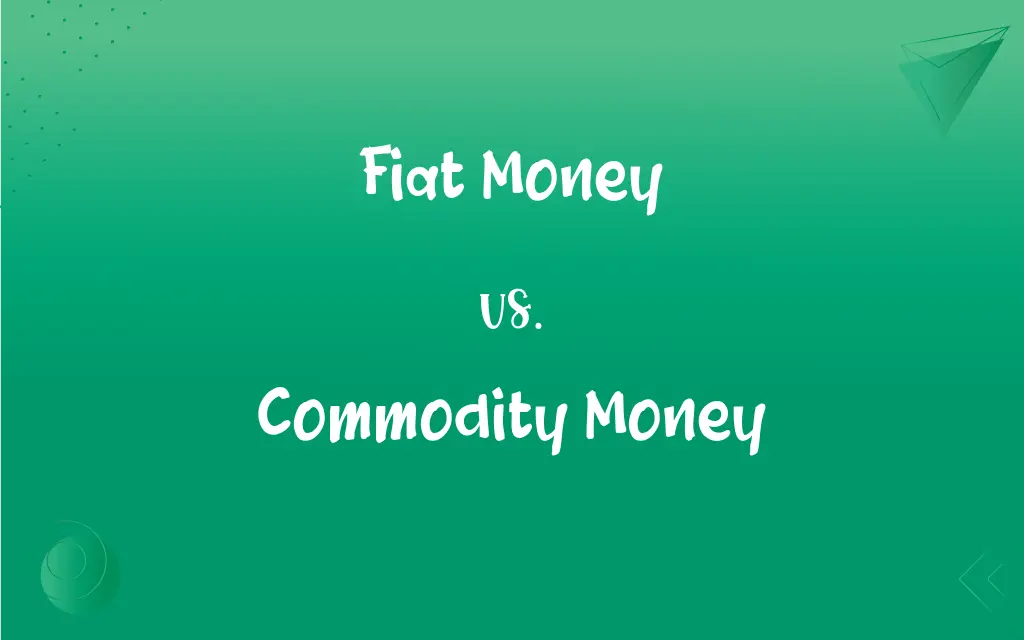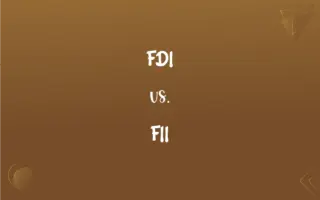Fiat Money vs. Commodity Money: What's the Difference?
Edited by Aimie Carlson || By Harlon Moss || Updated on October 10, 2023
Fiat money vs. Commodity money: Fiat money is currency without intrinsic value, backed by government decree, while commodity money has value in itself, often made from precious materials.

Key Differences
Fiat money and commodity money are both mediums of exchange, but their foundational principles differ significantly. Fiat money gets its value not from the material it's made of but from the trust and confidence of those who use it. Conversely, commodity money derives its value intrinsically, typically from the substance it's made of.
The concept of fiat money hinges on government regulation and decree. It's a system wherein the government declares a particular instrument as legal tender, even if that instrument doesn't have inherent value. On the other hand, commodity money is valuable by nature. Examples include gold or silver coins, where the coin's value comes from the precious metal it contains.
Fiat money, in its essence, can be a mere piece of paper, like banknotes, but it's the trust in the government or authority backing it that provides its worth. If trust diminishes, so does its value. In contrast, commodity money maintains value due to its physical properties. A gold coin, for instance, retains value because of the global demand for gold.
Economies around the world today primarily use fiat money as it provides more financial flexibility and can be easily regulated and controlled by monetary policy. Commodity money, while historically significant and a cornerstone in the evolution of money, is less prevalent today because it's harder to divide, transport, and regulate.
A potential downside of fiat money is that it can lead to hyperinflation if mismanaged since there's no physical limit to its production. Commodity money, however, naturally restricts overproduction because the commodity (like gold or silver) is limited in quantity.
ADVERTISEMENT
Comparison Chart
Basis of Value
Trust in the government or authority backing it
Intrinsic value of the material it's made of
Material
Often paper or polymer
Precious materials like gold, silver, or other commodities
Vulnerability
Can lead to hyperinflation if mismanaged
Limited by the quantity of the commodity available
Regulation
Easier to regulate with monetary policy
Harder to regulate due to its intrinsic value
Modern Prevalence
Predominantly used worldwide
Less prevalent, historically significant
ADVERTISEMENT
Fiat Money and Commodity Money Definitions
Fiat Money
Legal tender declared by the government.
Countries shifted to fiat money systems to have more control over monetary policies.
Commodity Money
Tangible assets that have value in themselves.
Before paper notes, societies relied on commodity money for transactions.
Fiat Money
Currency with value backed by government decree.
The US dollar is an example of fiat money.
Commodity Money
Physical goods used for trade based on intrinsic value.
In barter systems, goods like salt sometimes functioned as commodity money.
Fiat Money
Money whose worth is determined by market confidence.
If people lose faith in the economy, fiat money can devalue quickly.
Commodity Money
Money that can be exchanged for a specific quantity of a commodity.
A coin that can be traded for a set amount of grain is an example of commodity money.
Fiat Money
Money without intrinsic value but accepted for transactions.
Despite being just paper, fiat money is trusted for buying goods.
Commodity Money
A medium of exchange derived from a specific tangible item.
Silver bars, historically, were a form of commodity money.
Fiat Money
Currency not tied to physical commodities.
Unlike gold-backed currencies, fiat money's value is abstract.
Commodity Money
Money whose value is determined by the material it's made of.
Gold coins served as commodity money in ancient civilizations.
FAQs
What is fiat money?
Fiat money is currency without intrinsic value, backed solely by the trust in the government or authority that issues it.
Can fiat money become worthless?
Yes, if trust in the backing authority erodes, fiat money can lose its value.
Why isn't commodity money widely used today?
It's less flexible, harder to regulate, and not as convenient as fiat money for modern economies.
Who regulates fiat money?
Fiat money is regulated by governments and central banks.
How is commodity money different?
Commodity money derives its value from the material it's made of, such as gold or silver.
What backs the value of fiat money?
The trust in the government or authority issuing it, and its ability to maintain economic stability.
Can the supply of commodity money be easily increased?
No, it's limited by the availability of the commodity, like gold.
Were spices ever used as commodity money?
Yes, in certain periods and regions, spices like pepper were highly valuable and used like money.
Can digital currencies be considered fiat money?
Most digital currencies, like Bitcoin, are neither fiat nor commodity money; they're categorized as cryptocurrencies.
Can a currency shift from being fiat money to commodity money?
Historically, there have been shifts, but it's rare in modern times due to the complexities of global economies.
Can fiat money be converted to commodity money?
Historically, some fiat currencies were convertible to gold, but most modern currencies are not directly convertible.
Were cattle ever used as commodity money?
Yes, in some societies, cattle and other livestock were used as a form of commodity money.
Why is the US dollar considered fiat money?
It's backed by the trust in the US government, not by a physical commodity.
Why do countries use fiat money systems?
It provides more financial flexibility and can be easily regulated and controlled by monetary policy.
Is bartering a form of commodity money?
Not exactly. Bartering involves direct exchange of goods or services, but commodity money serves as a medium for such exchanges.
How can I tell if something is fiat money?
If its value comes from a decree or law and not the material it's made of, it's fiat money.
Are there risks to using fiat money?
Yes, mismanagement can lead to inflation or loss of value.
What's a benefit of commodity money?
Its value is tangible and doesn't rely on abstract trust.
Why isn't gold used as standard currency now?
The gold standard was abandoned by most countries for greater economic flexibility with fiat systems.
Is gold an example of commodity money?
Yes, when gold is used directly for transactions, it acts as commodity money.
About Author
Written by
Harlon MossHarlon is a seasoned quality moderator and accomplished content writer for Difference Wiki. An alumnus of the prestigious University of California, he earned his degree in Computer Science. Leveraging his academic background, Harlon brings a meticulous and informed perspective to his work, ensuring content accuracy and excellence.
Edited by
Aimie CarlsonAimie Carlson, holding a master's degree in English literature, is a fervent English language enthusiast. She lends her writing talents to Difference Wiki, a prominent website that specializes in comparisons, offering readers insightful analyses that both captivate and inform.































































